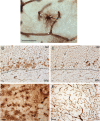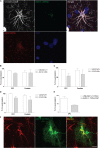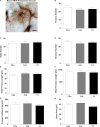Characterization of Vimentin-Immunoreactive Astrocytes in the Human Brain
- PMID: 32848635
- PMCID: PMC7406576
- DOI: 10.3389/fnana.2020.00031
Characterization of Vimentin-Immunoreactive Astrocytes in the Human Brain
Abstract
Astrocytes are commonly identified by their expression of the intermediate filament protein glial fibrillary acidic protein (GFAP). GFAP-immunoreactive (GFAP-IR) astrocytes exhibit regional heterogeneity in density and morphology in the mouse brain as well as morphological diversity in the human cortex. However, regional variations in astrocyte distribution and morphology remain to be assessed comprehensively. This was the overarching objective of this postmortem study, which mainly exploited the immunolabeling of vimentin (VIM), an intermediate filament protein expressed by astrocytes and endothelial cells which presents the advantage of more extensively labeling cell structures. We compared the densities of vimentin-immunoreactive (VIM-IR) and GFAP-IR astrocytes in various brain regions (prefrontal and primary visual cortex, caudate nucleus, mediodorsal thalamus) from male individuals having died suddenly in the absence of neurological or psychiatric conditions. The morphometric properties of VIM-IR in these brain regions were also assessed. We found that VIM-IR astrocytes generally express the canonical astrocytic markers Aldh1L1 and GFAP but that VIM-IR astrocytes are less abundant than GFAP-IR astrocytes in all human brain regions, particularly in the thalamus, where VIM-IR cells were nearly absent. About 20% of all VIM-IR astrocytes presented a twin cell morphology, a phenomenon rarely observed for GFAP-IR astrocytes. Furthermore VIM-IR astrocytes in the striatum were often seen to extend numerous parallel processes which seemed to give rise to large VIM-IR fiber bundles projecting over long distances. Moreover, morphometric analyses revealed that VIM-IR astrocytes were more complex than their mouse counterparts in functionally homologous brain regions, as has been previously reported for GFAP-IR astrocytes. Lastly, the density of GFAP-IR astrocytes in gray and white matter were inversely correlated with vascular density, but for VIM-IR astrocytes this was only the case in gray matter, suggesting that gliovascular interactions may especially influence the regional heterogeneity of GFAP-IR astrocytes. Taken together, these findings reveal special features displayed uniquely by human VIM-IR astrocytes and illustrate that astrocytes display important region- and marker-specific differences in the healthy human brain.
Keywords: GFAP; astrocyte; human; morphology; mouse; stereology; vimentin.
Copyright © 2020 O’Leary, Davoli, Belliveau, Tanti, Ma, Farmer, Turecki, Murai and Mechawar.
Figures









Similar articles
-
Widespread Decrease of Cerebral Vimentin-Immunoreactive Astrocytes in Depressed Suicides.Front Psychiatry. 2021 Feb 4;12:640963. doi: 10.3389/fpsyt.2021.640963. eCollection 2021. Front Psychiatry. 2021. PMID: 33613346 Free PMC article.
-
Development of vimentin and glial fibrillary acidic protein immunoreactivities in the brain of gray mullet (Chelon labrosus), an advanced teleost.J Comp Neurol. 2004 Feb 9;469(3):413-36. doi: 10.1002/cne.11021. J Comp Neurol. 2004. PMID: 14730591
-
Glial fibrillary acidic protein is differentially expressed across cortical and subcortical regions in healthy brains and downregulated in the thalamus and caudate nucleus of depressed suicides.Mol Psychiatry. 2016 Apr;21(4):509-15. doi: 10.1038/mp.2015.65. Epub 2015 Jun 2. Mol Psychiatry. 2016. PMID: 26033239
-
Implication of cerebral astrocytes in major depression: A review of fine neuroanatomical evidence in humans.Glia. 2021 Sep;69(9):2077-2099. doi: 10.1002/glia.23994. Epub 2021 Mar 18. Glia. 2021. PMID: 33734498 Review.
-
Glial fibrillary acidic protein (GFAP): modulation by growth factors and its implication in astrocyte differentiation.Braz J Med Biol Res. 1999 May;32(5):619-31. doi: 10.1590/s0100-879x1999000500016. Braz J Med Biol Res. 1999. PMID: 10412574 Review.
Cited by
-
A molecular brain atlas reveals cellular shifts during the repair phase of stroke.bioRxiv [Preprint]. 2024 Aug 22:2024.08.21.608971. doi: 10.1101/2024.08.21.608971. bioRxiv. 2024. Update in: J Neuroinflammation. 2025 Apr 18;22(1):112. doi: 10.1186/s12974-025-03437-z. PMID: 39229128 Free PMC article. Updated. Preprint.
-
Ion Channel Drugs Suppress Cancer Phenotype in NG108-15 and U87 Cells: Toward Novel Electroceuticals for Glioblastoma.Cancers (Basel). 2022 Mar 15;14(6):1499. doi: 10.3390/cancers14061499. Cancers (Basel). 2022. PMID: 35326650 Free PMC article.
-
Kisspeptin signaling in astrocytes modulates the reproductive axis.J Clin Invest. 2024 Jun 11;134(15):e172908. doi: 10.1172/JCI172908. J Clin Invest. 2024. PMID: 38861336 Free PMC article.
-
Vimentin and p53 Immunoreactivity in Cases of Traumatic Brain Injury.J Pers Med. 2025 Mar 31;15(4):135. doi: 10.3390/jpm15040135. J Pers Med. 2025. PMID: 40278314 Free PMC article.
-
Efficient derivation of functional astrocytes from human induced pluripotent stem cells (hiPSCs).PLoS One. 2024 Dec 4;19(12):e0313514. doi: 10.1371/journal.pone.0313514. eCollection 2024. PLoS One. 2024. PMID: 39630626 Free PMC article.
References
-
- Cahoy J. D., Emery B., Kaushal A., Foo L. C., Zamanian J. L., Christopherson K. S., et al. (2008). A transcriptome database for astrocytes, neurons, and oligodendrocytes: a new resource for understanding brain development and function. J. Neurosci. 28 264–278. 10.1523/jneurosci.4178-07.2008 - DOI - PMC - PubMed
LinkOut - more resources
Full Text Sources
Molecular Biology Databases
Miscellaneous

